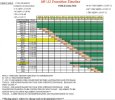Flash, you sound like someone college kid trying to make his point that he is correct over all others because he knows more than everyone. DC tour giving you insight into matters that make you go hmmm? I have no dog in this fight, doesn't concern me. However, would it not make more sense to look at up and coming programs? It seems to me that since the V-22 program has run the majority of its course...meaning from concept to fleet acquisition, concentrating on programs that are young in design would be more appropriately considered for termination. You're going to find yea and nay's for every program. What makes one or the other correct? Gonna have to demonstrate with facts is my guess.
I think it is very valuable to look at recent programs for flaws in not only the process but also in the thinking of everyone involved. Many of the same arguments that I raised in this now separate thread are the ones that were raised throughout the length of the program. I think it is very easy and lazy to say that since a program is bought and paid for that we shouldn't look at its effectiveness, both from a procurement perspective and an operational one.
You are certainly right that it is a bit like crying over spilt milk, and I did get sucked into minutiae that I certainly did not intend to get in an argument about in this thread. I don't know nearly as much about the V-22 as most Marine aviators, but I am not an idiot high school kid either (at least I don't think so). My main point remains though, I think the jury is still out on whether or not the V-22 buy is really worth the cost for the capability. A capability that could be done in large parts by much cheaper, albeit less capable, aircraft. Secretary of Defense Cheney certainly didn't think so in 1991.
Why should that still be argued over? Well, you can take it as a lesson for the many other programs that are in the pipe for not only the Marines but for the rest of the services. The same arguments that the Marines make for the V-22, increased capability at a greater cost, can be made for most programs. The issue is at what cost is the capability worth it? While most of the arguments for the V-22 are valid, the same arguments were used for the Comanche, Crusader and A-12. And they are still used for the F-22, EFV and FCS. But all of those programs have their futures in doubt right now due to massive cost overruns.
We are likely facing a future where there is significantly less money for acquisitions and where overall cost will be weighed even more heavily when compared to capability and effectiveness of weapon systems. The single-minded focus with which the Marines pursued the purchase of the V-22 might not pay off in the future, especially when there are much cheaper alternative available, no matter what is 'necessary' for the service. It may even turn out to be a huge detriment, instead of not having the best weapon system you may not end up with none at all. The Marines, and the rest of the services, seem not to have learned this lesson yet. The Army is the one service that has borne the brunt lately, with 3 major programs being cut even when their procurement was deemed necessary. But I believe the other services will have to endure some similar cuts sooner or later. I think the Navy saw the writing on the wall with the Zumwalt class.
That is why I think it is still valuable to argue about current acquisitions, like the V-22. There will have to be compromises made, like with the Super Hornet. But the Navy needed aircraft on its flight decks and fast to replace the F-14 and A-6 and we really didn't have an alternative. As a result we got a plane on time and on budget with new capabilities added every day. If the services continue to go down the path of 'the best and nothing else' then they might end up with nothing. It is time that the services and its people, including us here on AW, wake up to that reality.
And just to let you know I am not on a tour here in DC, I have a career here now. I know, the horror.




